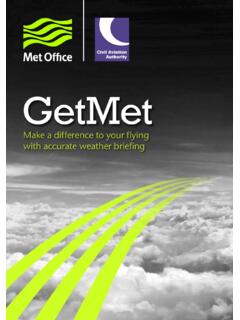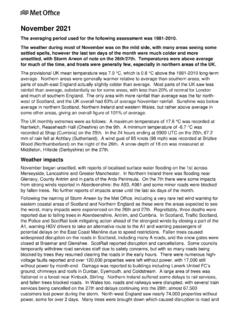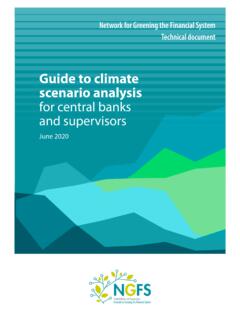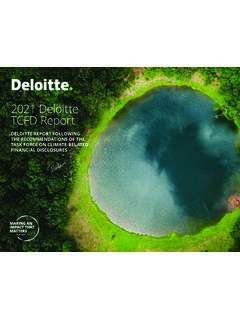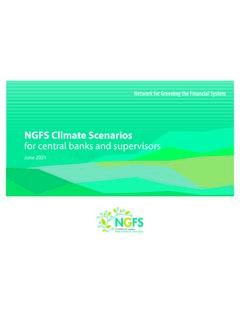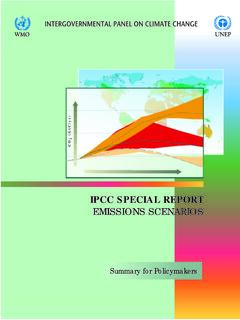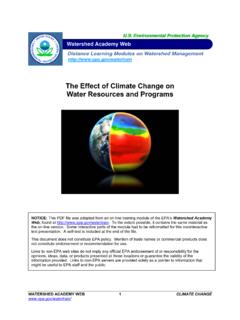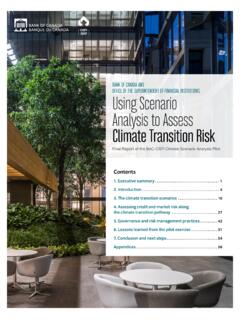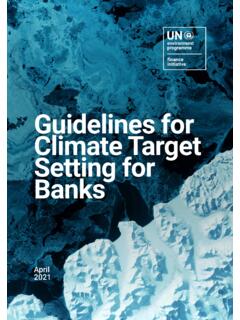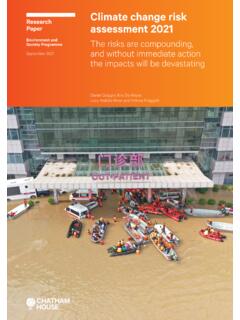Transcription of UKCP1 uidance Representative Concentration Pathways
1 UKCP18 Guidance: Representative Concentration PathwaysWhat are RCPs?To model and predict future climate it is necessary to make assumptions about the economic, social and physical changes to our environment that will influence climate Concentration Pathways (RCPs) are a method for capturing those assumptions within a set of scenarios . The conditions of each scenario are used in the process of modelling possible future climate specify concentrations of greenhouse gases that will result in total radiative forcing increasing by a target amount by 2100, relative to pre-industrial levels. Total radiative forcing is the difference between the incoming and outgoing radiation at the top of the atmosphere.
2 Radiative forcing targets for 2100 have been set at , , and watts per square metre (W m-2) to span a wide range of plausible future emissions scenarios and these targets are incorporated into the names of the RCPs; , , and Each pathway results in a different range of global mean temperature increases over the 21st century (see Table 1).The RCP Pathways represent a broad range of climate outcomes and are neither forecasts nor policy recommendations. They include a wide range of assumptions regarding population growth, economic development, technological innovation and attitudes to social and environmental sustainability.
3 Each pathway can be met by a combination of different socioeconomic assumptions. More information on RCPs is available in van Vuuren et al (2011).Table 1 The increase in global mean surface temperature averaged over 2081-2100 compared to the pre-industrial period (average between 1850-1900) for the RCP Pathways (best estimate, 5-95% range). From IPCC AR5 WG1 Table Source: Met Office Crown Copyright 2 of 3 What are the RCP warming levels?The RCPs can be represented by the levels of temperature change that result from each (blue in figure 1) represents a pathway where greenhouse gas emissions are strongly reduced, resulting in a best estimate global average temperature rise of C by 2100 compared to the pre-industrial period.
4 (red in figure 1) is a pathway where greenhouse gas emissions continue to grow unmitigated, leading to a best estimate global average temperature rise of C by 2100. and are two medium stabilisation Pathways , with varying levels of do RCPs differ from previous emissions scenarios ?UKCP09 used an earlier set of emissions scenarios that did not include such a comprehensive range of factors as were used in the most recent Intergovernmental Panel on climate Change (IPCC) Fifth Assessment report. The older Special Report on Emission scenarios (SRES), used in the UKCP09 projections, did not include any policies to limit climate change and thus did not consider climate change mitigation.
5 The increasing relevance of mitigation scenarios led the IPCC to request the climate research community to develop a new set of scenarios , or were introduced to better facilitate interactions between the scientific communities working on climate change, adaptation and mitigation. Unlike with SRES, RCPs enable the costs and benefits of long-term climate goals to be evaluated. RCPs are referred to as Pathways to emphasise they are not definitive and could be realised via more than one underlying socioeconomic 1 Global mean temperature projections from a climate model (called MAGICC6) relative to a pre-industrial average (1850-1900) for (blue), (green), (yellow) and (red) and the older SRES scenarios (dashed coloured lines).
6 Source: Met Office Crown Copyright 3 of 3 Met Office and the Met Office logo are registered trademarks. 00939As a result of the different methods used to construct the SRES scenarios and the RCPs, it is not possible to directly compare the two sets. Table 2 indicates the similarities between the , J., Palin, E., Liddicoat, S et al. Response of the HadGEM2 Earth System Model to Future Greenhouse Gas Emissions Pathways to the Year 2300. Journal of climate (2013) 26 , 2000: IPCC Special Report on Emissions scenarios . Prepared by Working Group III of the Intergovernmental Panel on climate Change. Cambridge University Press, Cambridge, United Kingdom, and New York, NY, , M.
7 , Smith, , Calvin, K et al. The RCP greenhouse gas concentrations and their extensions from 1765 to 2300. Climatic Change (2011) 109: 213. , J., Meinshausen, M & Knutti, R. Global warming under old and new scenarios using IPCC climate sensitivity range estimates. Nature climate Change (2012) 2: 248-253. Vuuren, , Edmonds, J., Kainuma, M. et al. The Representative Concentration Pathways : an overview. Climatic Change (2011) 109: 5. 2 SRES scenarios that are most similar to the new RCPs, in terms of median global temperature increase by 2100





